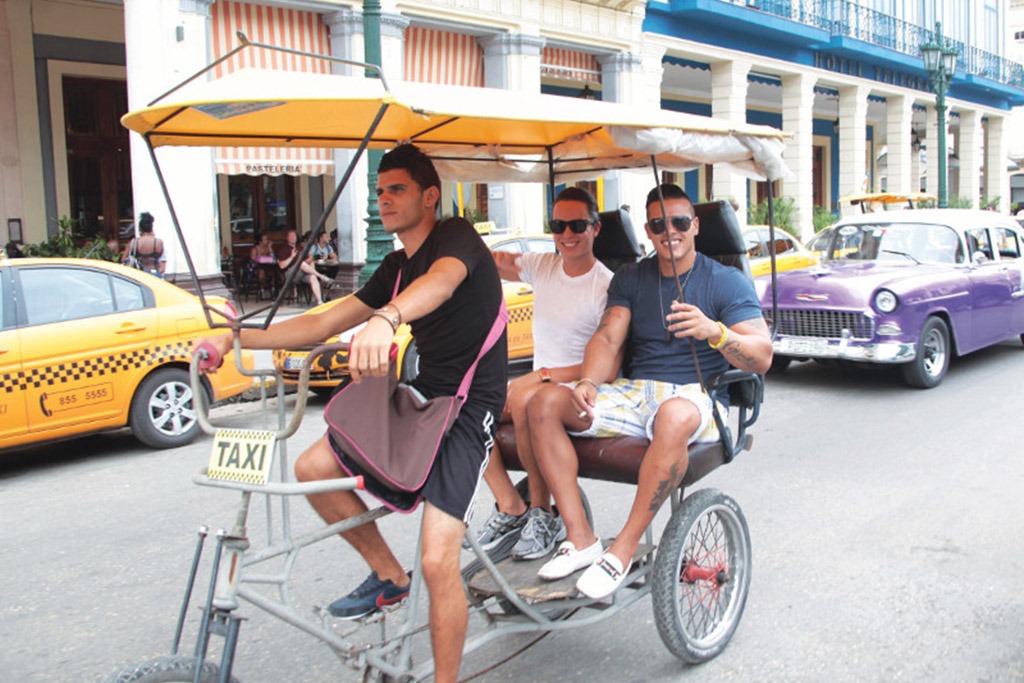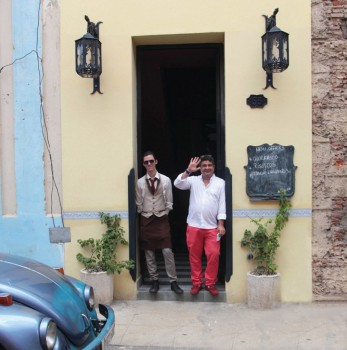Apparently, it is highly unusual for the government to give visitors who are part of a planned tour such free time. After realizing that there may be some leniency in their rigid schedule, I beg, like the literary nerd I am, that our driver stop by Ernest Hemmingway’s home where he wrote Old Man in the Sea. I am told that after Hemmingway’s children came to see it recently, they closed it for renovations. As our van heads down a village street, I begin to smell the salt water. Little shops and restaurants dot the street, and men and women walk carelessly through the middle of the road with fishing poles. In front of us is an old and crumbling Spanish fort, long docks that seemingly stretch to nowhere, and a round, baby-blue plaza with a bust of Hemmingway. A man sings “Guantanamera” alone, children run up to us shouting “amigo,” and an old woman sits, legs crossed, dwarfed by the fort, gazing out. “This is Cojimar, where Hemmingway was inspired to write his novel.” Oscar tells me. Sitting here by the bust, as I hand Tootsie Pops to the children to quiet them, and watch fishermen row back into the docks looking miniscule compared to the ocean, and I can see how Hemmingway fell so in love with this town, the mysteries of Cuba, and, more importantly, the sea. “But the old man always thought of her as feminine and as something that gave or withheld great favors, and if she did wild or wicked things it was because she could not help them,” he wrote in Old Man in the Sea in 1952.
I’ve made everyone late to the beach (by Cuban standards) as people usually begin leaving around 4 P.M., but it’s still filled with fresh-face tanned youths sipping Cuban rum, and parsnip-colored tourists lounging in rented chairs protected by rainbow-colored umbrellas. “Mi Cayito is a place where the gay community can really be free,” Oscar tells us as a couple of transwomen walk by topless. We find a comfy spot and make our way into the crystal-blue Caribbean waters while the locals ogle at our foreignness. Unlike other gay beaches in the Caribbean, this feels empty and safe (though I would, of course, use common sense). We begin to recognize a familiar cast of characters who proudly promenade up and down the sand runway sporting everything from thongs to one pieces, holding hands, swigging glass rum bottles, kissing, and celebrating life. We easily chat with locals who are interested in why we’re visiting, and we excite them when we say how much we have always wanted to visit Cuba, their home.

Havana Centro
As the sun begins to set, it casts that oh-so-picture-perfect tint of colors only found in the Caribbean.
That night, Oscar takes us for a stroll along the Malecón where under the moonlight miles and miles of men and women sit along the waterfront during the weekend. The massive crowds and the people’s carefree no-rush attitude impress me. The whole idea of hanging with friends to just sit on a ledge and talk the night away seems so foreign. As cell phones are quite expensive and most social-media websites are blocked, nobody is looking at tiny computer screens. They are engaged, interested, and more importantly valuing each other’s time together. Gay groups sit among the straight couples, and you’ll easily notice them by their not-so-discreet gazes. As we walk to another “cruising” area, every crevice or ledge is filled with people. We rest under a dark and Sleepy Hollow-esque statue of “Don Quixote in Vedado” and eavesdrop on Spanish conversations (my Spanish teacher would be so proud I picked up the word bottom, pasivo).
Havana’s gay scene and nightlife doesn’t just take place on the streets. Oscar takes us to a place called Café Cantante below the Nacional Theatre that’s hosting an event called il Divino. First, I visit the top of the building that overlooks the lit-up Plaza de la Revolución where an illuminated Che Guevera and Camilo Cienfuegos act as guardians over the cars rolling around the circle. Downstairs, tables are set up, and, slowly, people begin to trickle in. It’s illuminated like a 90’s roller rink, and we’re hardly expecting much modern music, or much at all. Then the DJ plays US Top 40 with videos projected on both sides of the stage, and by half past midnight, the oh-so-sexy crowd has overtaken the seats and the bar is packed. A host comes on speaking machine-gun Spanish, getting the crowd fired up. He shouts out to us few Americans, Germans, Spanish, and then a dance number ensues. We’re mesmerized and watch a string of performances, while doing our best talking to the locals. I learn quickly that buying a beer is way more effective than chitchatting. We ask when the famous drag queen will hit the stage, and we’re told 5:30 A.M., and I am afraid my tired eyes will lose this battle with Father Time.
Old Havana is crumbling,” our guide tells us. “Over one building a day currently collapses in the city, but it’s because of tourism that we’re slowly beginning to rebuild and restore,” he adds. The parts we experience sing of Spain and most of the buildings in the tourist areas are still in good condition.

Gay-Owned La California
When we arrive in the tourist-heavy part of Old Havana, it looks just like I had always imagined. I’m standing adjacent to the old lighthouse. Here, a young guard sits reading a book, she brushes her newly dyed red hair out of her eyes and she angles her head up and uses her book as a visor to see the clouds rolling in high above the centuries-old buildings and trees. A wind whips their delicate leaves, and they fall to the cobble-stoned plaza. Still green and still with much more time to be had catching Caribbean sunlight, they become part of the sediment that has held the stone together for centuries. They are pushed farther into the ground by opened-toed tourist sandals belonging to curious visitors and re-smushed by handed-down Nikes belonging to local vendors hawking Che Guavera trinkets. One of the tree’s wide-base roots stretches far across to the El Templete monument and curves, snake-like toward a bust of Christopher Columbus. The branches touch the neo-classical monument gently brushing the façade like a grandmother smoothing the cheek of her new grandchild.
“A storm is coming,” the guard tells me while collecting ten CUCs and placing the bill into her fanny pack. “Just a few minutes,” she says opening up the faded-white doors of El Templete. “I will have to shut the doors if it rains.” Inside El Templete there are three massive floor-to-ceiling canvases by the French painter (who later moved to Cuba) Jean Baptiste Vermay. The exquisite pieces give a first-hand look into the importance of Cuba. They show, and more importantly allow me to feel, the power, wealth, and divinity that came from the establishment of the European New World.
Stepping out from the tomb-like quiet of the monument onto one of the three main squares in Havana, Plaza de Armas, reveals a bustling scene. I manage to make it around to a few vendors at the Second-Hand Book Market, where eager salesmen who are trying to pawn off mostly Spanish-language books about the Revolution quickly surround me. As I settle a deal for a five-CUC paperback of The Old Man and the Sea and an assortment of old prayer cards, I spot a raindrop stream down a graphic novel, Revolucion Cubana. The vendors parachute plastic tarps over their stands with such routine indifference I can only imagine how many times this happens. I stroll with my group around the square. Drop. “It’s just a light drizzle,” we convincingly repeat.
Drop, drop. Through the rain, we dodge into little shops, taking in the local characters, and make our way through two more major plazas. Each reveals an other-worldly, different-time charm. A young girl in an orange quinceñera dress floats out of an old church, her parents snapping photos, as she poses against the beautiful stonework, British boys stumble through centuries-old courtyards with cigars and rum and Cokes, and old women whose dresses are wet and sandals are worn sneak up behind tourists begging for a CUC.
We make it to Plaza Vieja and duck into a microbrewery called Factoria Plaza Vieja and sample the beers made on the premises and watch the lively cast of characters. An old woman dances alone in the rain and is joined by little children, while small dogs step across the cobblestone square and weave through the modern sculpture of a rooster. The once droplets have turned into monsoon-like conditions, and I watch the water flow rapidly through the Old City. “The city has seen much worse,” our guide tells us, reflecting on past hurricanes. Through Spanish columns an image of Che Guvera looks almost dystopian in the near-zero visibility.
The rain luckily subsides, and we are back in Plaza de Armas. The guard, protected by a small umbrella, with near-perfect dry red hair, is still waiting by the monument under dripping leaves. “They say,” Oscar notes, “This tree has been here since the founding of Cuba.” I look up at the branches still moving like a flag from the ocean winds. He takes my hand and places it against the trunk. “See how smooth it is?” he says as I brush my hand against an almost sanded-down ring on its trunk. “Each year, people line up all the way down the street to celebrate the birth of the nation, and we walk around the tree while still touching it,” he says like an old prophet. “Touch the tree and think of a wish, dream, hope, or something you’re thankful for and walk around three times, and with each time drop a coin at the base.”
One. I trace the tree first with my eyes closed thinking hard about a personal wish that I send up through the trunk, and I open my eyes while carefully stepping and see the square as it may have appeared in the beginning and see the hopes and dreams of a colonizing people. Two. I come around again and thank the tree for modern-day Cuba for the people, for their hospitality, and I wish that they too will find answers for the problems that they live with each day. Three. I come around for a final time and think of Cuba’s future, and I thank the tree that I am already a small insignificant part of it.
HAVANA, CUBA RESOURCES
Havana Tours worked with Pride World Travel to create our itinerary and gave us a loveable, fun, and intelligent guide, Oscar. www.havanatur.cu
Pride World Travel. As part of the IsramWorld portfolia, Pride World will handle every detail when it comes to getting into Cuba and receiving the VIP treatment. The 2015 departures will feature Havana as well as other cities for a week-long Cuba experience. www.prideworldtravel.com
Meliá Cohiba Hotel, Calle 1ra, La Habana, Cuba. Tel: +53-7-833-3636. This five-star property is one of the few luxury hotels in Havana and offers expert service, a pool, bars, restaurants, and enviable views. www.melia.com


